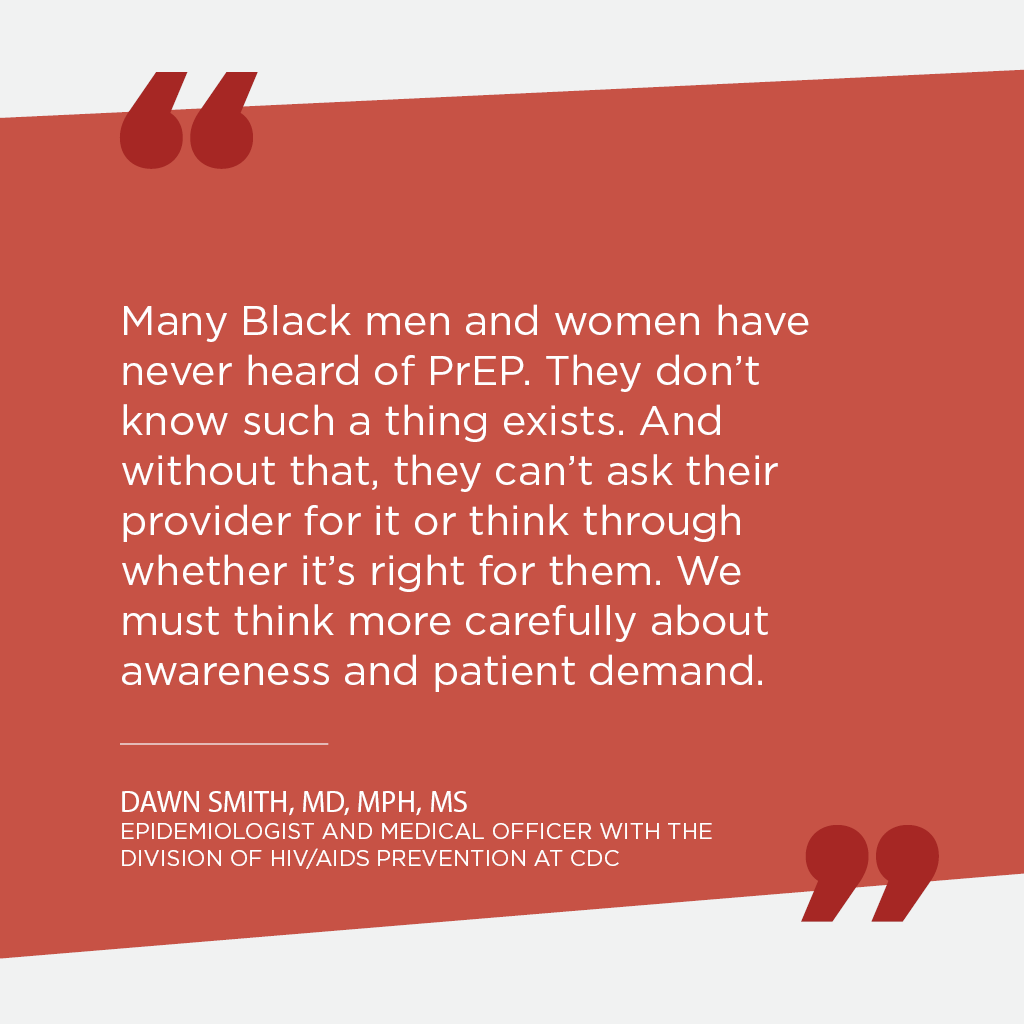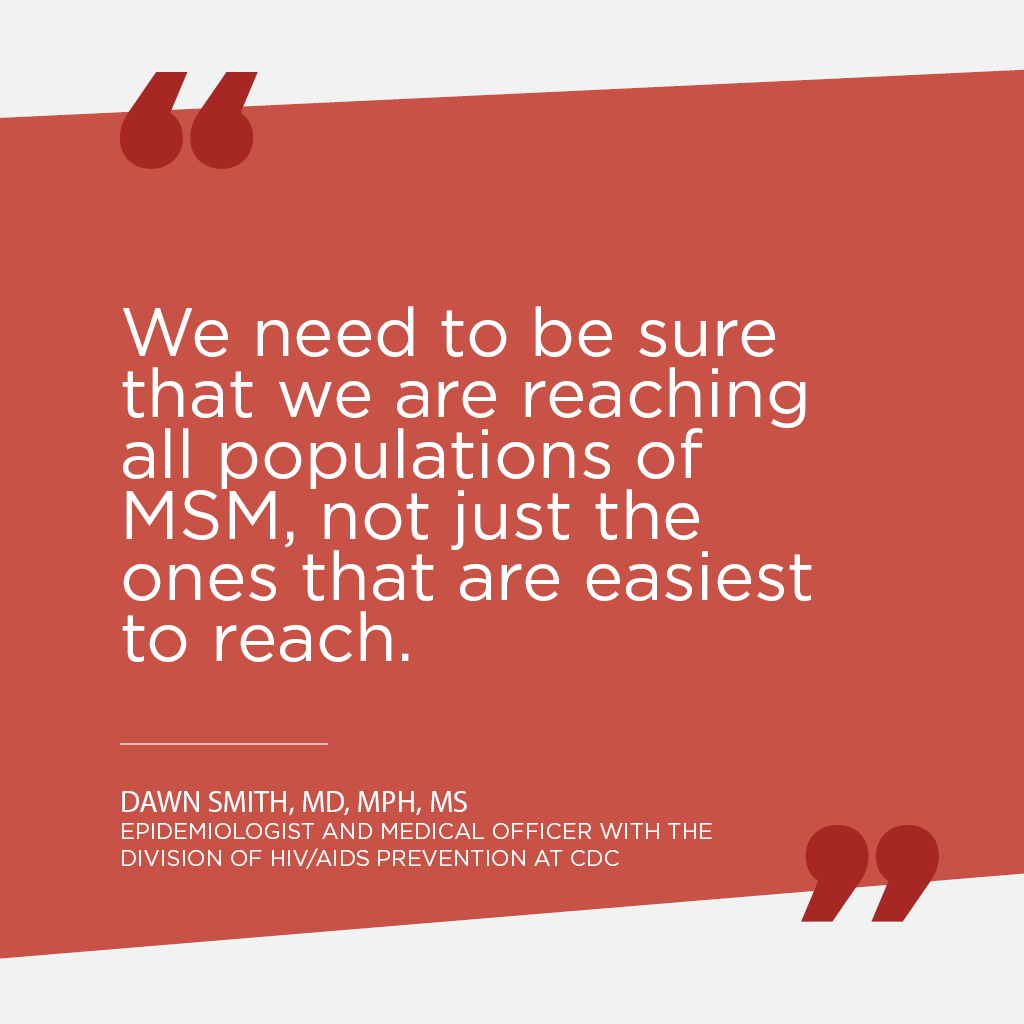Dawn Smith, MD, MPH, MS, is an epidemiologist and medical officer with the Division of HIV/AIDS Prevention (DHAP) at CDC’s National Center for HIV/AIDS, Viral Hepatitis, STD and TB Prevention (NCHHSTP)
Q: You have been researching PrEP for many years including four years at the Centers for Disease Control and Prevention field station in Botswana. Can you talk a little bit about what motivated you to get involved in this work?
When I went to Botswana, I was setting up a clinical trial site to do my research. Before that, I had been involved in the post-exposure prophylaxis (PEP) guidelines development. When we got a site set up in Botswana, we decided to not do the trial that we had initially thought we would for a variety of reasons. We had an infrastructure, and we weren’t sure what to do with it. That was around the time that the first PrEP trials were beginning, so my CDC supervisors said, “Well how about if we do a PrEP trial?” After reading up on it and discussing, we decided that made good sense. We started some of the behavioral research that we needed before and then eventually started the TDF 2 trial there.
When I came back from Botswana in late 2006, I was pretty convinced that PrEP was going to work to prevent new infections. Because these drugs could now knock down viral load once you were already infected, it made perfect sense that they could also block new infections. When I came back, I said to my team, “I want to focus on how we’re going to use PrEP if the trials show efficacy.” We started doing a variety of both community preparedness activities and talking with other federal agencies about what their rules would be if PrEP proved effective. That way when the trial results were announced, we had an initial handle on what we thought should be done. These findings and my curiosity encouraged me to keep pushing myself to contribute to this work.
Q: You recently published a paper in Annals of Epidemiology on PrEP need among different subgroups, specifically Black gay and bisexual men and Black women. Can you tell us about the research you conducted and some of the main findings?
We found that an estimated 1.1 million adults had indications for PrEP use in 2015. That included more than 810,000 men who have sex with men (MSM), 255,000 heterosexually active adults (HET), and 72,000 persons who inject drugs, as well as 500,000 African Americans, 280,000 Latinos, and 300,000 whites. Among HET, there were more than 176,000 females and 81,000 males that had indications.
Because African Americans comprised the highest number of adults with indications, we knew increasing PrEP use in this population must be the highest priority. MSM also remain a priority. As a result, these estimates can be used as denominators to assess PrEP coverage and impact on HIV incidence at subnational levels.
For background on the study, one of the key factors that we felt CDC was responsible for was monitoring how the uptake was going. If we’re trying to implement the new intervention, who is it getting to? How is it getting out? Is it being used? Is it being used by the people who have the highest incidence? Initially, we focused on just measuring prescriptions. But then, the more we thought about it, we thought we needed a denominator because we can’t say “X” number of thousands of people are the goal for PrEP use in the U.S. Instead we want to be able to talk about among people who need it, what proportion of those people are actually receiving it. So, we put together a small group to develop denominators, and that resulted in the 2015 MMWR where we were able to look just at the number of adults, at a national level, by transmission risk group.
For a variety of technical reasons related to the surveys we were using, we were not able to specify by race and ethnicity. So, we thought about it, took time and poked around, looked at some other examples, and finally came up with a method that we thought was valid to estimate the number of people with indications at the state level, as well as by transmission risk group and race/ethnicity. That resulted in that paper in Annals of Epidemiology. We’re now working with a similar method to get to county-level estimates, which will be particularly helpful for the larger counties in the U.S.
Q: What are some ways that we can overcome barriers to Black gay and bisexual men and Black women getting on PrEP?
 One of the things that was striking to us when looking at the analysis is that when you looked by race, not by transmission risk group, the highest indications for PrEP were among Black men and Black women. The evidence shows that these sub-populations need more attention.
One of the things that was striking to us when looking at the analysis is that when you looked by race, not by transmission risk group, the highest indications for PrEP were among Black men and Black women. The evidence shows that these sub-populations need more attention.
I think one thing is that many Black men and women have never heard of PrEP. They don’t know such a thing exists. And without that, they can’t ask their provider for it or think through whether it’s right for them. We must think more carefully about awareness and patient demand.
Additionally, I think there is an assumption that if we make the information broadly available, all parts of the population will hear about it. But that seems not to be the case. There are some things that we don’t understand about the information networks of these populations. We’ve spent a lot of time working on the sexual networks of different populations, but I don’t think we’ve spent enough time trying to understand where these people get health information. Who are their preferred spokespeople? Who do they trust about health information? Once we have a better handle on that, we can handle the dissemination of information about PrEP more effectively. We do hear anecdotally that, particularly among younger Black MSM, there’s some resistance to using PrEP based on misinformation that they’ve heard like serious side effects. We need to do a better job of figuring out who they trust and get the right message there.
The second barrier for both groups is on the provider side. Most men, particularly younger men, don’t go to health care providers regularly for personal health care annual checkups. They tend to go episodically for an acute illness or symptoms. Women, on the other hand, engage with medical care more frequently because of their reproductive health – pap smears or pregnancy or for other kinds of checkups. What we’re finding is that providers who are seeing Black men and women for either episodic care or annual health care, are not identifying their risk for HIV acquisition and are not offering them PrEP. For example, if a young man or woman comes into your clinic and you diagnose that they have gonorrhea, the next thing you should do is talk to them about both PrEP and condom use. But that’s frequently not happening. What’s happening instead is, “I’m treating your gonorrhea,” and then maybe giving some broad health education about sexually transmitted infections. But as a clinician, I’m not taking that next step. And some of that is because clinicians are also not as aware of PrEP as we would like them to be. Some of it is because it involves antiretroviral medicine and they think an infectious disease doctor should do it. They don’t understand that this is a preventive use of the medication and just like they do preventative care for other conditions; they can now do preventive care for HIV.
We must get those two pieces together. Then there is the issue of cost, and not so much the medication, but affording health care visits and lab tests that are associated with PrEP. This is especially true in the states that did not have Medicaid expansion. If I’m a young MSM, I’m unlikely to be eligible for Medicaid based on income alone because, in the non-expansion states, there are other criteria. So again, there are methods to help people with the medication costs but trying to organize the information on how to cover all the remaining costs—and make sure providers and patients are aware—is vital.
Q: How can the availability of data on PrEP—like AIDSVu’s interactive maps of PrEP use—contribute to reducing the disparity between PrEP need and PrEP use?
Particularly for the public health community, everything always starts with data. I think the resources that are available on AIDSVu and that CDC provide show us where the need is, and where the use is. This is the first step in generating consensus in the public health community that this is a serious problem we have to tackle. I think we’re used to seeing lots of disparity in all kinds of health care issues. And so, I think there is a tendency to sort of say, “Well yeah, but there’s disparities in access to cardiovascular disease services and to prostate cancer screening and all kinds of things. So, this is just another thing.” But the data and visualization on the severity of HIV disparities is startling to many people and helps build momentum in finding solutions and implementing programs to make sure this doesn’t continue.
Q: What up-and-coming research on PrEP are you most excited about and why?
I’m excited there’s more implementation science research beginning around PrEP. Or, in other words, research to understand what are the different delivery models that reach the important populations. And not just to start PrEP, but to keep people on PrEP over time. One of the early phases of the implementation science was looking at how we can get people recruited and into PrEP programs. It has shown us there are some serious barriers and we must try navigation. We must try co-location. We must try pharmacy delivery. There’s a whole variety of models for how to deal with that initial linkage to care. But what we also see now is a drop off once people have started. That’s particularly troublesome for the populations who have the highest risk of HIV incidence. We also see problems in adherence in some of those populations. If you don’t take it regularly or if you stop PrEP before your risk ends, then you’re still at risk for HIV and we haven’t really accomplished what we want to accomplish with PrEP. I’m excited that people are now bringing implementation science tools to try to understand if there is an approach for adherence that works for Young Black MSM. Or is there an approach that everybody likes, but research shows it doesn’t actually work to increase adherence or retention in care.
I think implementation science will tell us a lot about what are the successful strategies. That’s what’s most exciting to me right now.
Q: In honor of National Gay Men’s HIV/AIDS Awareness Day on September 27, what is your message to the HIV/AIDS community?
We need to increase use of PrEP by MSM who have an ongoing risk of HIV exposure. We need to be sure that we are reaching all populations of MSM, not just the ones that are easiest to reach. I think we’ve done a good job of providing PrEP in urban areas where there’s a gay men’s health center or academic health center. What we haven’t done is make sure that that younger MSM, Black MSM, rural MSM, etc. have the same access as those lucky enough to be near a health center that focuses on the health of MSM.




